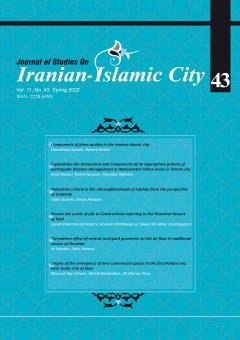Explanation the Dimensions and Components of an appropriate pattern of Earthquake Disaster Management in Deteriorated Urban Areas in Tehran city
Subject Areas : Teachings of improvement and renovation in worn-out urban contextsasad razani 1 , Kamal Nozari 2 , Mojtaba Rafiyan 3
1 - MSc of Urban Planning, Department of Urban and Regional planning, Institute of Humanities and Social Studies, Academic Center for Education, Culture & Research (ACECR), Tehran, Iran
2 - PhD of Geography and Urban Planning, Tehran, Iran
3 - Associate Professor, Department of Urban Planning, Faculty of Art and Architecture, Tarbiat Modares University, Tehran, Iran
Keywords: Disaster Management, Deteriorated Areas, Earthquake, Prevention, Tehran City, Smart PLS,
Abstract :
Due to the high vulnerability of deteriorated urban areas, a systematic precaution is needed to provide features and components of an effective pattern for disaster management in these areas that clarify the dimensions of decision-making in earthquake risk management in them. The purpose of this research is to investigate the dimensions and components of an appropriate disaster management pattern in deteriorated urban areas in order to control and reduce the damage caused by the earthquake in the period before its occurrence (prevention stage) in deteriorated urban areas in Tehran. The research method is applied in terms of purpose and descriptive-analytical in terms of method, and because it tries to establish a relationship between the dimensions and components of earthquake disaster management in deteriorated urban areas, it is exploratory. After identifying the dimensions and components of the disaster management pattern in deteriorated areas in documentary studies (theoretical foundations, Iranian and global experiences). It has been accurate and prioritized by referring to experts and proprietors. In the next step, the coefficient of significance of each component is specified and the results of the questionnaires evaluated and validated in content by using the PLS software. The results of the research show that in the field of disaster management in the deteriorated urban areas of Tehran. It is necessary to have a risk management and pre-thinking and pre- disaster management view before looking at the disaster management with a post- disaster view in these areas. In the pre-disaster stage, attention to different dimensions and considering the effective components of each of these dimensions in disaster management (social and cultural, physical-environmental, economic, structural and managerial, legal- rule and infrastructures dimensions) in deteriorated urban areas and their application can ultimately lead to decreasing vulnerability and promoting the resilience of these area in the face of various events, including the earthquakes.
آژانس همکاریهای بینالمللی ژاپن (جایکا) (1380)، مرکز مطالعات زلزله و زیستمحیطی تهران بزرگ، گزارش نهایی پروژه ریزپهنهبندی لرزهای تهران بزرگ.
داوری، علی و آرش رضازاده (1393)، مدلسازی معادلات ساختاری با نرمافزار PLS، انتشارات آگاه، تهران.
ربیعی، علی و سمیرا السادات حسینی (1392)، مدیریت بحران،مفاهیم، الگوها و شیوههای برنامهریزی در بحران طبیعی، انتشارات تیسا، تهران.
شرکت بازآفرینی شهری ایران (1396)، آمار مساحت و جمعیت بافتهای ناکارآمد شناسایی شده در شهرهای کشور.
شرکت مادر تخصصی عمران و بهسازی شهری ایران (1394)، دفتر شماره هفت، نوسازی بافت فرسوده با مشارکت کارکنان: محله خوب بخت، منطقه 15 تهران.
طرح جامع شهر تهران (1385)، شهرداری تهران.
کركه آبادى، زینب و سید مرتضی میرنژاد (1399)، «بررسى عوامل مؤثر برآسیب پذیرى بافت فرسوده نواحى شهرى (نمونه موردى: شهر فریدونكنار)»، فصلنامه دانش پیشگیری و مدیریت بحران، 152-162.
قدیری محمود (1386)، كاهش آسیبپذیری در برابر زلزله؛ ضرورت نگرش همهجانبه در برنامههای توسعة پنجسالة ایران، سومین كنفرانس بینالمللی مدیریت جامع بحران تهران.
مداح، مریم، مجید عبدالهی و مجید صالحی نیا (1392)، «تدوین راهكارهاى مدیریت بحران در بافتهای فرسوده شهرى در منطقه 12 شهر تهران»، نشریه دانش پیشگیری و مدیریت بحران، شماره 9.
مرکز آمار ایران (1395)، سرشماری عمومی نفوس و مسکن سالهای 1385و 1395.
منزوی، مهشید، محمد سلیمانی، سیمین تولایی و اسماعیل چاوشی (1389)، «آسیبپذیری بافتهای فرسوده بخش مرکزی شهر تهران در برابر زلزله (مورد: منطقه 12)»، پژوهش های جغرافیای انسانی (پژوهشهای جغرافیایی)، دوره 42، شماره 73.
مهرجو، محسن و نسرین گیاه چین (1391)، «نقش برنامهریزی راهبردى در كاهش خطرپذیرى زلزله در بافتهای فرسوده شهرى منطقه 20 شهر تهران»، نشریه دانش پیشگیری و مدیریت بحران، شماره 3.
مهندسان مشاور بوم سازگان تهران (1385)، طرح جامع تهران، مرکز مطالعات و برنامه ریزی شهر تهران.
وزارت راه و شهرسازي (1385). مصوبه شوراي عالی شهرسازي و معماری در مورد شاخص های شناسايي بافت فرسوده .
نقدی، آمنه، عزتاله مافی و مهدی وطنپرست (1400)، «تحلیلی بر وضعیت شاخص های تاب آوری در بافتهای فرسوده شهری مطالعه موردی: بافت فرسوده شهر فاروج»، نشریه تحقیقات کاربردی علوم جغرافیایی، سال 21، شماره 60.
Roy. B and Sethi G (eds.). (2012). Fiscal Federalism in Latin America: Argentina, Colombia, Mexico and Peru. Washington, D.C.: World Bank.
Bulkeley, H., (2010) ,Cities and the Governing of Climate Change, Annual Review of Environment and Resources, 35 (229-253).
Fornell. C and Larcker. D.F, (1981), Evaluating Structural Equation Models with Unobservable Variables and Measurement Error , Journal of Marketing Research , Vol. 18, No. 1.
Cohen C. and Werker, E., (2008) , The Political Economy of ‘Natural’ Disasters, Harvard Business School, Harvard Business School Working Paper No. 08-040. P. 795.
Kapucu, N, & Ozerdem, A. (2013). Managing emergencies and crises. Boston: Jones & Bartlett.
Rubin, Claire B. (Ed). (2007). Emergency Management: The American Experience, 1900-2005, Washington, DC: Public Entity Risk Institute.
UNISDR/UNESCAP (2012) The Asia-Pacific Disaster Report 2012: Reducing Vulnerability and Exposure to Disasters. Geneva and Bangkok: International Strategy for Economic and Social Commission for Asia and the Pacific.
URL1- https://www.unisdr.org/ /files/1037_hyogoframeworkforactionenglish.pdf.
URL2- https://www.unisdr.org/files/43291_sendaiframeworkfordrren.pdf.


